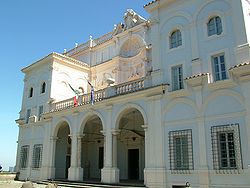


The Villa Falconieri is a villa in Frascati, Italy.



The Villa Falconieri is a villa in Frascati, Italy.
The villa was originally called Villa Rufina, having been was initially built by Monsignor Alessandro Rufini. Later it was enlarged thanks to Pope Paul III, dates back to 1546. In 1628 Orazio Falconieri purchased the villa and commissioned Francesco Borromini to oversee its renovation. His aim was for him and his brother, Cardinal Lelio Falconieri, to be buried there [1]
Important architects worked on the design such as Antonio da Sangallo the Younger and Borromini. The interior houses frescoes by Pier Leone Ghezzi, Giacinto Calandrucci, Ciro Ferri, Niccolò Berrettoni, and others. The park is a splendid Italian gardens enlarged in the 17th century, with small lake bordered by cypresses created in the 18th century.[ citation needed ]
The German writer Richard Voss lived here for 25 years and wrote several novels as Villa Falconieri, Roman Fever, The Son of Volsca and others; he called the Villa as "my shining house". For this reason, Villa Falconieri was always dear to the German community of Rome. [2]
In 1905, the Villa was bought by the German banker Ernst von Mendelssohn-Bartholdy of Berlin, a nephew of the composer Felix Mendelssohn Bartholdy. In 1907, he gave it as a gift to emperor Wilhelm II. On April 6, 1911 the Crown Prince William and Princess Cecilie visited the villa and decided on some restorations. [ citation needed ]
In 1921, the Villa was expropriated by Italian State. Villa Falconieri was damaged by US bombing during World War II while being used as the headquarters of Field Marshal Albert Kesselring, but masterly work restored its previous splendor.[ citation needed ]
Since 2016, Villa Falconieri has been the headquarters of the Accademia Vivarium Novum Latin academy, a cultural center of excellence that has entrusted the decoration of its rooms to an appreciated re-adaptation of classical symbolism, giving the Villa Falconieri an iconographic experience linked to the international vocation of this world campus of Humanism. [3]


The Quirinal Hill is one of the Seven Hills of Rome, at the north-east of the city center. It is the location of the official residence of the Italian head of state, who resides in the Quirinal Palace; by metonymy "the Quirinal" has come to stand for the Italian president. The Quirinal Palace has an extension of 1.2 million square feet.

A Roman villa was typically a farmhouse or country house in the territory of the Roman Republic and the Roman Empire, sometimes reaching extravagant proportions.
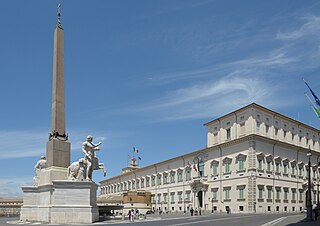
The Quirinal Palace is a historic building in Rome, Italy, one of the three current official residences of the President of the Italian Republic, together with Villa Rosebery in Naples and the Tenuta di Castelporziano, an estate on the outskirts of Rome, some 25 km from the centre of the city. It is located on the Quirinal Hill, the highest of the seven hills of Rome in an area colloquially called Monte Cavallo. It has served as the residence for thirty popes, four kings of Italy and twelve presidents of the Italian Republic.
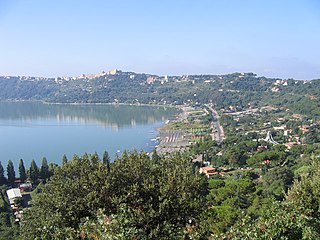
Castel Gandolfo, colloquially known as Castello in the Castelli Romani dialects, is a town located 25 km (16 mi) southeast of Rome, in the Lazio region of Italy. Situated on a hilltop in the Alban Hills with panoramic views of Lake Albano, Castel Gandolfo is home to approximately 8,900 residents and is renowned as one of Italy's most scenic towns. It is a member of the I Borghi più belli d'Italia association.

Frascati is a city and comune in the Metropolitan City of Rome Capital in the Lazio region of central Italy. It is located 20 kilometres (12 mi) south-east of Rome, on the Alban Hills close to the ancient city of Tusculum. Frascati is closely associated with science, being the location of several international scientific laboratories.

Hadrian's Villa is a UNESCO World Heritage Site comprising the ruins and archaeological remains of a large villa complex built around AD 120 by Roman Emperor Hadrian near Tivoli outside Rome.

The Palazzo Barberini is a 17th-century palace in Rome, facing the Piazza Barberini in Rione Trevi. Today, it houses the Galleria Nazionale d'Arte Antica, the main national collection of older paintings in Rome.
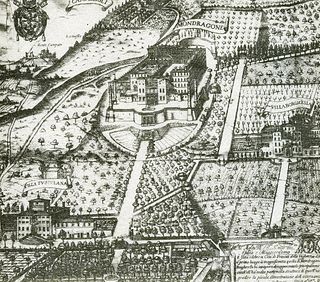
Villa Mondragone is a patrician villa originally in the territory of the Italian comune of Frascati, now in the territory of Monte Porzio Catone. It lies on a hill 416m above sea-level, in an area called, from its many castles and villas, Castelli Romani about 20 km (12 mi) southeast of Rome, near the ancient town of Tusculum.
An airraid of USAAF planes against Frascati, a historic town near Rome, Italy, was made on 8 September 1943. The target was the German General Headquarters for the Mediterranean zone (O.B.S.) and the Italian headquarters, scattered in buildings and villas near the town.

Monteroni di Lecce (Salentino: Muntrùni is a town and comune in the province of Lecce, in Apulia, southern Italy. In 2008, it had 13,800 inhabitants. It is 7 kilometres from Lecce, in the Salento – the historic Terra d'Otranto.
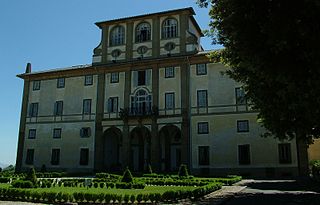
Villa Rufinella, also called Villa Tuscolana, is a villa in Frascati, Italy.

Villa Lancellotti is a villa in Frascati, Italy, the nearest to the town centre. This villa was constructed in 1582 by Cardinal Bonanni. It was sold in 1617 to the banker Roberto Primo who constructed the 'teatro d'acqua' at the far end of the garden. The theatre is a direct copy of that at the nearby Villa Mondragone, for whom Primo acted as a banker. The clock, or 'orologio' was added in the nineteenth century while the villa was in the ownership of the Lancellotti family.
Villa Muti is a villa in Frascati, Italy, now in the communal territory of Grottaferrata.

The Basilica of San Giovanni dei Fiorentini is a minor basilica and a titular church in the Ponte rione of Rome, Italy.


The Church of Saint Lucy in Selci is an ancient Roman Catholic church, located in Rome, dedicated to Saint Lucy, a 4th-century virgin and martyr.

The Palazzo Falconieri is a palace in Rome, Italy formed in the seventeenth century as a result of remodelling by the Baroque architect Francesco Borromini. It is the home of the Hungarian Academy Rome, since its foundation in 1927. It is located between Via Giulia and Lungotevere, with entrances to both; it is near Palazzo Farnese and a few houses down and across Via Giulia from the church of Santa Caterina della Rota in the Rione of Regola. From 1814, it was occupied by cardinal Joseph Fesch, Napoleon's uncle.
Georg Thür, complete name Carl Georg Thür, was a German architect and Prussian official builder whose designs for university buildings had a decisive influence on the Prussian university landscape.

Vom Himmel hoch, MWV A 10, is a Christmas cantata by Felix Mendelssohn. He composed the chorale cantata, based on Luther's hymn "Vom Himmel hoch, da komm ich her", in 1831, setting selected stanzas with unchanged lyrics for soprano and baritone soloists, a five-part mixed choir (SSATB), and orchestra. The cantata was first published by Carus-Verlag in 1983, with an English version From heav'n on high.